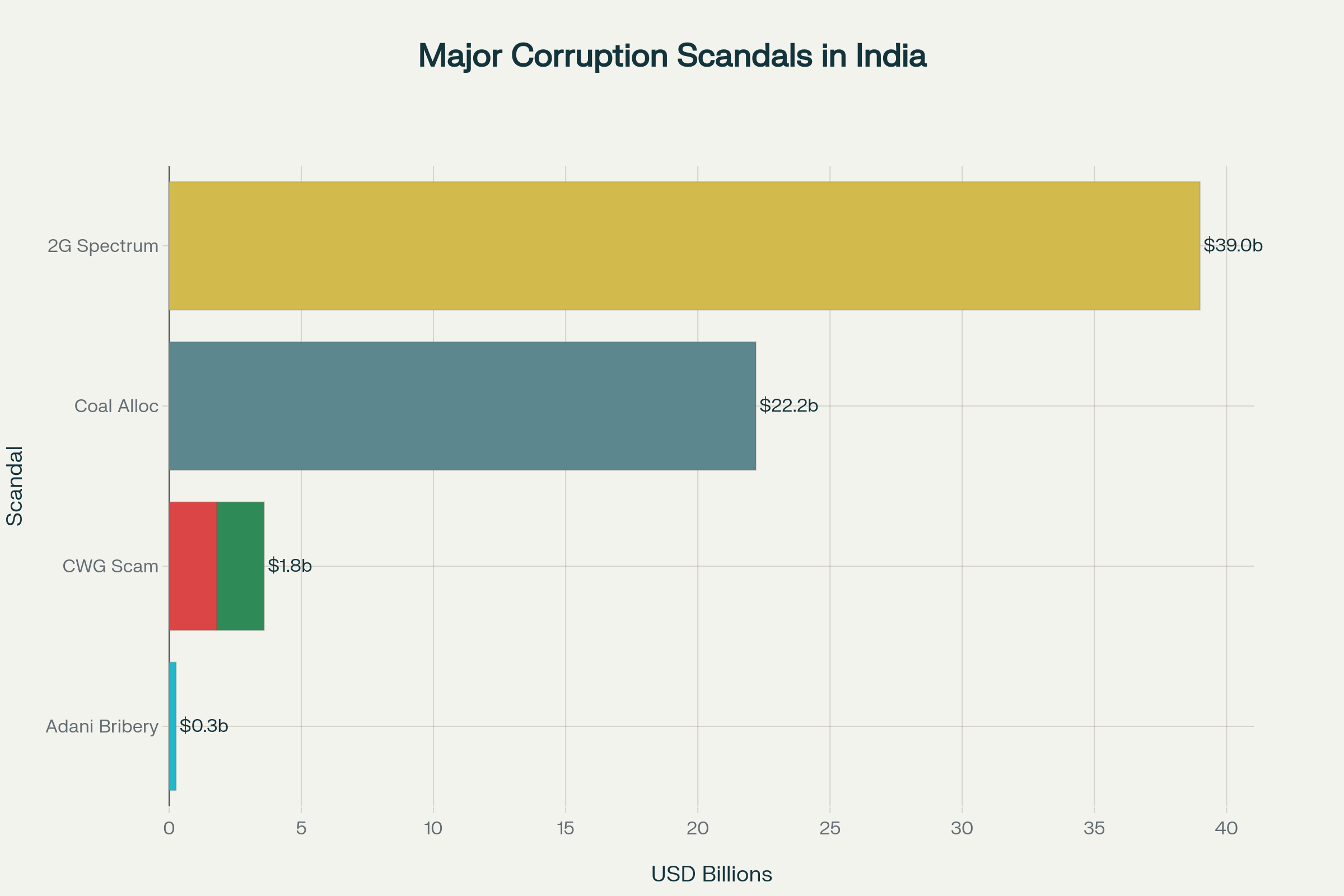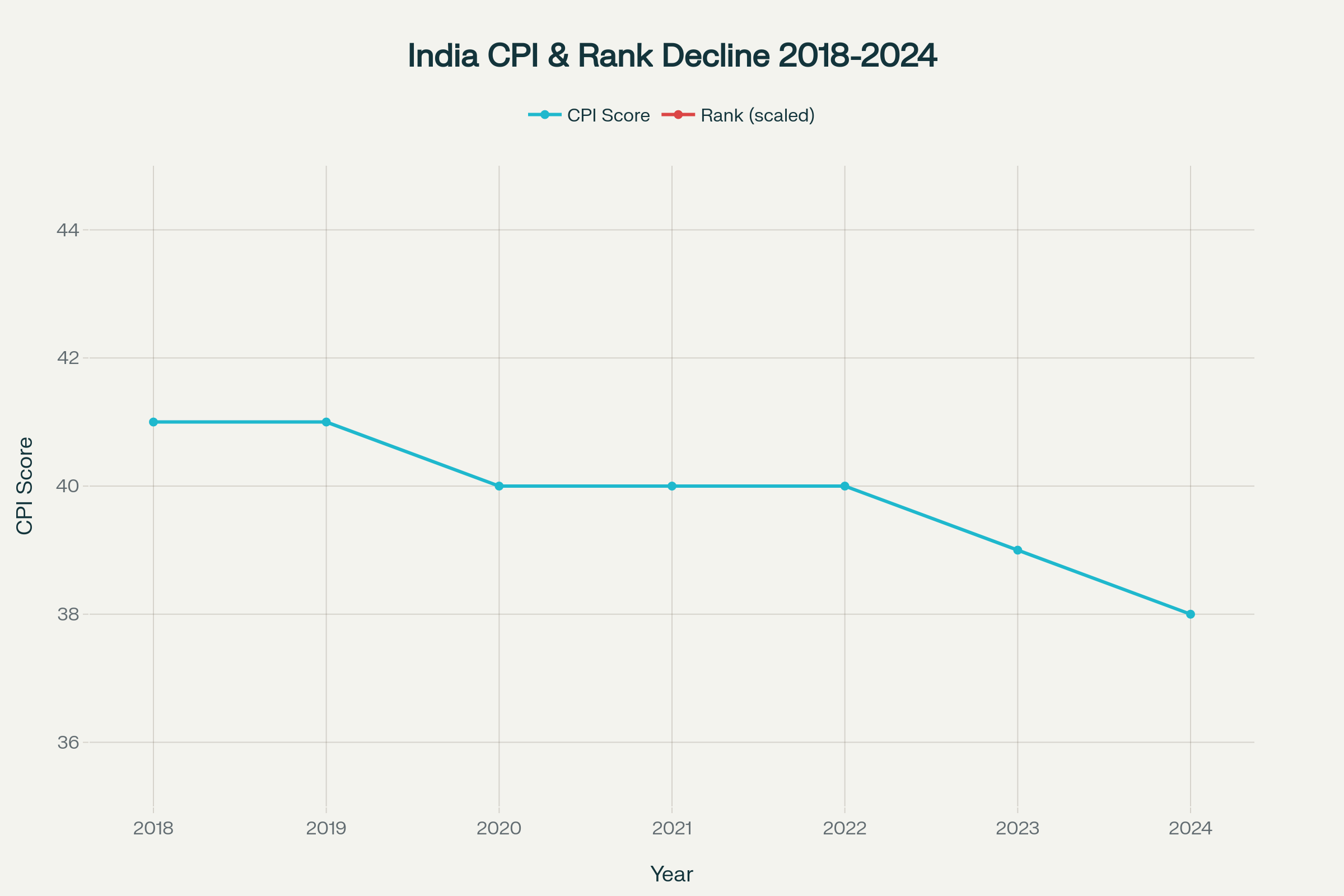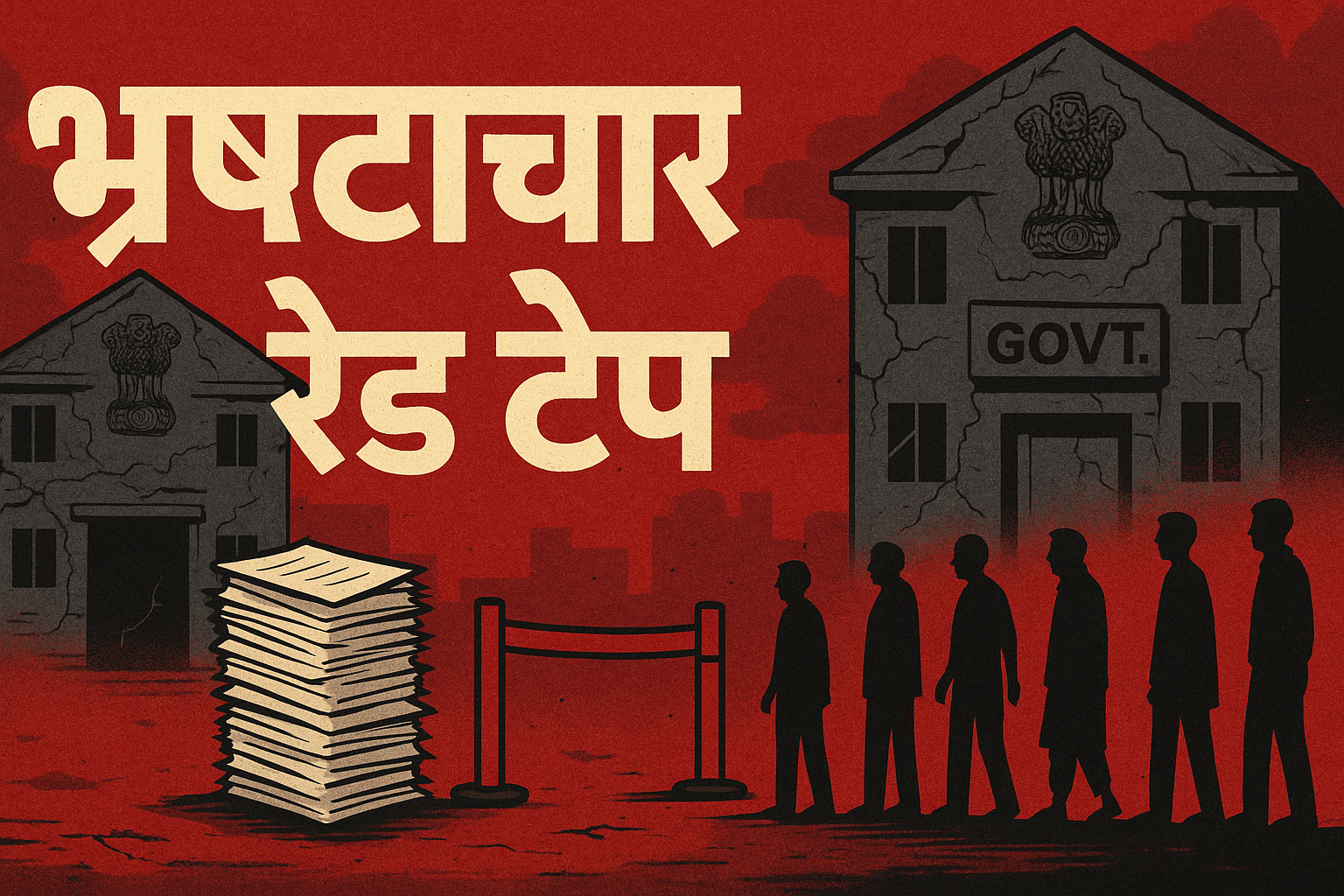Corruption by Design in India: A Systemic Analysis of Institutional Flaws
India’s corruption problem extends far beyond individual moral failures or isolated incidents of graft. The country’s corruption crisis is fundamentally a product of institutional design—systems, structures, and processes that have been deliberately or inadvertently crafted to enable, sustain, and even incentivize corrupt practices. This comprehensive analysis reveals how corruption in India is not an aberration but rather the predictable outcome of flawed institutional architecture that has its roots in colonial administration and has been perpetuated and refined in the post-independence era.
The scale of corruption in India is staggering, with major scandals causing losses exceeding $65 billion to the public exchequer over the past decade alone 1234. However, the focus on high-profile cases often obscures the more fundamental issue: the systematic design of institutions that make corruption not just possible but inevitable. From the License Raj era to contemporary crony capitalism, India’s governance structures have consistently created environments where corrupt practices flourish 567.
Colonial Origins and Institutional Inheritance
The East India Company Legacy
The institutional foundations of corruption in India trace back to the colonial period, particularly under the East India Company’s rule 89. The Company’s governance model was explicitly extractive, designed to maximize profit through systematic manipulation of local systems, bribery of local rulers, and the creation of opaque administrative processes 68. Historical documents reveal that corruption wasn’t incidental to colonial rule—it was a strategic tool for control and extraction 8.
The East India Company deliberately misread Mughal orders and engaged in fraudulent activities to secure trading privileges. The 1717 firman, for instance, was not intended as a broad concession but as specific privileges subject to periodic approval. However, Company officials systematically exploited these arrangements through bribery and manipulation 8. Robert Clive’s acquisition of enormous personal wealth through manipulation of local rulers and trade laws became the template for institutionalized corruption 6.
Structural Design for Control
The British introduced dual administrative systems, particularly in Bengal, where they retained fiscal power (diwani) while leaving judicial and policing powers (nizamat) in native hands 6. This deliberate fragmentation created bureaucratic confusion designed to avoid accountability while facilitating extraction. The system ensured that responsibility could be shifted, accountability avoided, and corrupt practices concealed within the complexity of overlapping jurisdictions 6.
The colonial administration also established the practice of using local intermediaries—Daroghas and other native officials—who became centers of corruption 8. Reports from the period describe how these positions became “centers of oppression” rather than efficient administrative units 8. The colonial system thus created a structure where corruption was not just tolerated but systematically embedded in the governance architecture.
Post-Independence Continuity: The License Raj System
Inherited Structures and New Complexities
Rather than dismantling colonial administrative structures, post-independence India largely retained them while adding new layers of control 59. The Indian Administrative Service was essentially the Indian Civil Service rebranded, maintaining the same hierarchical, opaque, and control-oriented approach to governance 6. The promise of democratic governance was undermined by the continuation of extractive institutional designs.
The License Raj system, operational from 1950 to 1991, represents perhaps the most systematic institutionalization of corruption in modern India 51011. Under this system, businesses required licenses for virtually every economic activity, with up to 80 government agencies needing to approve private companies before they could operate 510. This wasn’t merely bureaucratic inefficiency—it was a deliberate design that created multiple rent-seeking opportunities for officials 5.
Engineered Scarcity and Rent-Seeking
The License Raj created artificial scarcity through regulatory bottlenecks, providing bureaucrats and politicians with the power to grant or deny economic opportunities 57. The system was deliberately complex and opaque, ensuring that navigating it required paying bribes or engaging political intermediaries 510. As one analysis noted, the correlation between high regulatory burden and corruption has been consistently demonstrated across countries and time periods 12.
The discretionary nature of licensing decisions meant that success in business depended more on political connections than on efficiency or innovation 513. This system benefited large corporations that could afford to maintain extensive networks of political connections while systematically excluding smaller businesses and entrepreneurs 5. The design created a vicious cycle where corruption became necessary for economic survival, further entrenching the system.
Judicial System: Self-Regulation and Impunity
The In-House Procedure
India’s judiciary has constructed perhaps the most sophisticated system for protecting itself from accountability through the “in-house procedure” for handling misconduct allegations 1415. Established in the late 1990s, this system ensures that judges can only be investigated by other judges, creating a closed loop that effectively immunizes the judiciary from external scrutiny 14.
The in-house procedure operates without transparency, with no public disclosure of investigations or outcomes 1416. This design ensures that even serious allegations of corruption rarely lead to consequences. Recent examples include Justice Yashwant Varma, who was merely transferred rather than prosecuted despite allegations involving burnt cash found at his residence 1615. The system’s design makes it virtually impossible to establish patterns of judicial corruption or hold judges accountable 14.
Constitutional Barriers to Accountability
The constitutional impeachment process for judges requires a two-thirds majority in both houses of Parliament, setting the bar so high that no judge has ever been successfully impeached despite numerous scandals 16. This design effectively creates judicial immunity that borders on impunity. The requirement for the Chief Justice of India’s approval before registering criminal cases against judges further insulates the judiciary from accountability 16.
The Supreme Court has consistently resisted external oversight mechanisms, arguing that they threaten judicial independence 14. However, this resistance has created a system where corruption within the judiciary can flourish with minimal consequences, as demonstrated by the numerous high-profile cases of judicial misconduct that have gone unpunished 1416.
Electoral System: Design for Opacity and Influence
The Electoral Bonds Scandal
The Electoral Bonds system, introduced in 2017 and struck down by the Supreme Court in 2024, represents a textbook example of corruption by design 1718. The system was ostensibly created to bring transparency to political funding, but its actual design achieved the opposite 17. By allowing anonymous donations while giving the ruling party exclusive access to donor information through the State Bank of India, the system created a perfect mechanism for political extortion 1718.
The design enabled what critics called “legalized corruption,” allowing corporate entities to purchase political influence through anonymous donations while protecting them from retaliation by opposition parties 17. The asymmetry in the system was stark: the BJP received approximately $788 million through electoral bonds, while the main opposition Congress party received only $134 million 18. This wasn’t coincidental—it was the predictable result of a system designed to favor the party in power.
Quid Pro Quo by Design
Documents revealed during the Supreme Court proceedings showed clear patterns of quid pro quo arrangements 1718. Companies would purchase electoral bonds after receiving government contracts or before crucial regulatory decisions 18. The timing and patterns of donations strongly suggested that the system was being used not just for political funding but for systematic corruption 1718.
The system’s design eliminated the possibility of genuine anonymity while creating the appearance of transparency. Only the ruling party had access to complete information about donors, creating information asymmetry that could be exploited for political and economic advantage 1718. This design made the electoral bonds system a tool for both corruption and political coercion.

Major corruption scandals in India showing estimated financial losses to highlight the scale of institutional corruption by design
Contemporary Manifestations: Crony Capitalism and Resource Allocation
The Adani Case Study
The recent indictment of Gautam Adani and associates by U.S. authorities for allegedly paying $265 million in bribes to secure solar power contracts illustrates how corruption has evolved in contemporary India 192021. The case reveals a sophisticated system where government auctions are designed to favor specific companies, regulatory processes are manipulated to reduce competition, and international investors are misled about anti-corruption practices 22.
Investigation by The Reporters’ Collective revealed that the Union government designed solar power auctions with conditions that effectively ensured Adani Group’s dominance 22. The auction structure discouraged competition through restrictive bidding conditions and strategic exemptions, with only two other participants, one of which bid the maximum permitted tariff and immediately sold assets to Adani Group 22. This represents corruption by design at the policy level, where the rules of competition are crafted to predetermined outcomes.
Coal Allocation: Systematic Favoritism
The coal allocation scandal (Coalgate) demonstrates how resource allocation systems can be designed to enable corruption 3423. Between 2004 and 2009, the government allocated 194 coal blocks without competitive bidding, resulting in estimated losses of ₹1.86 lakh crore to the exchequer 34. The system’s design deliberately avoided transparent auction processes, instead relying on discretionary allocation that favored politically connected entities 23.
The Comptroller and Auditor General’s investigation revealed that the allocation process lacked objective criteria, transparent procedures, or meaningful oversight 423. Many recipients were found to have inflated their financial capabilities or lacked relevant experience in mining 23. The system was designed in a way that made such manipulation not just possible but inevitable, as there were no meaningful checks or verification mechanisms 23.
Bureaucratic Red Tape: Engineered Inefficiency
Colonial Legacy in Modern Form
India’s bureaucratic systems retain the essential character of colonial administration: complex, opaque, hierarchical, and designed for control rather than service 2425. The persistence of red tape serves multiple functions beyond mere inefficiency—it creates dependency relationships, generates opportunities for rent-seeking, and maintains power hierarchies inherited from the colonial period 2426.
Red tape in India is not simply the result of poor planning or bureaucratic incompetence. Research shows that bureaucratic complexity often serves strategic purposes for those in power 2427. Complex procedures create opportunities for officials to extract payments for “speed money,” while lengthy processes discourage challenges to official decisions 2726. The design of bureaucratic processes often includes deliberate inefficiencies that can be bypassed through corrupt payments 27.
Digital Transformation and Persistent Design Flaws
While India has made significant investments in digital governance, the fundamental design problems persist 28. The e-office system has reduced the use of physical red tape, but the underlying procedural complexity remains 28. Many digital systems simply automate existing corrupt processes rather than redesigning them for transparency and efficiency 28.
The persistence of red tape despite digitization efforts suggests that the problem is not merely technological but systemic 2826. Officials retain discretionary powers within digital systems, and the fundamental incentive structures that reward corrupt behavior remain unchanged 26. Without addressing the underlying design flaws that create opportunities for corruption, technological solutions alone cannot solve the problem.

India’s declining performance on the Corruption Perception Index from 2018-2024, showing both score deterioration and worsening global rank
Institutional Failure: Anti-Corruption Mechanisms by Design
Central Vigilance Commission and Central Bureau of Investigation
India’s primary anti-corruption institutions—the Central Vigilance Commission (CVC) and Central Bureau of Investigation (CBI)—are designed in ways that limit their effectiveness 12930. The CBI requires government approval to investigate senior officials, creating a fundamental conflict of interest where the institution being investigated controls the investigating agency 29. This design ensures that high-level corruption rarely faces meaningful investigation 1.
The CVC, while granted statutory status, lacks operational independence and sufficient powers to effectively combat corruption 131. Its supervision of the CBI and Enforcement Directorate is limited by political oversight and budgetary constraints 1. The design of these institutions reflects a fundamental tension: they are supposed to investigate corruption within the very system that created and controls them 130.
Lokpal: Designed for Ineffectiveness
The Lokpal and Lokayuktas Act, passed in 2013 after sustained civil society pressure, was designed with built-in limitations that ensure its ineffectiveness 1232. The selection process for Lokpal members involves political appointees, the institution lacks adequate resources and staff, and its jurisdiction excludes key areas where corruption flourishes 3332. The design reflects a compromise between the appearance of anti-corruption action and the reality of preserving existing power structures 32.
The implementation of the Lokpal has been deliberately slow and incomplete, with key positions remaining unfilled for extended periods 33. This isn’t administrative incompetence—it’s systematic undermining of an institution that could potentially threaten existing corrupt networks 3330. The design ensures that the Lokpal exists as a symbolic concession to public pressure rather than an effective anti-corruption mechanism.
Economic Impact and Social Costs
Development Consequences
Corruption by design has profound consequences for India’s development trajectory 23435. The systematic misallocation of resources through corrupt processes undermines infrastructure development, reduces the effectiveness of social programs, and creates massive inefficiencies in public spending 3510. The coal scam alone represented a loss equivalent to several years of social spending on health and education 34.
The design of corrupt systems creates perverse incentives that prioritize rent-seeking over productive economic activity 3435. Resources flow not to their most efficient uses but to actors with the best political connections 57. This systematic misallocation has contributed to India’s slow progress on human development indicators despite significant economic growth 35.
Inequality and Democratic Deficit
Corruption by design systematically advantages the wealthy and politically connected while excluding ordinary citizens from economic opportunities 527. The License Raj system, for example, benefited large corporations that could afford to navigate complex regulatory requirements while shutting out small entrepreneurs 5. Contemporary crony capitalism continues this pattern, concentrating wealth and economic power in the hands of a few well-connected individuals and families 3637.
This concentration of economic power translates into political influence, creating a self-reinforcing cycle where corrupt elites use their wealth to capture regulatory processes and design systems that further advantage them 3638. The result is not just economic inequality but a democratic deficit where policy outcomes are determined more by private interests than public welfare 1739.
Reform Challenges and Systemic Resistance
Vested Interests and Path Dependency
Reforming corruption by design faces fundamental challenges because the existing system creates powerful vested interests committed to maintaining the status quo 130. Officials, politicians, and businesses that benefit from corrupt systems have strong incentives to resist reform 3032. Moreover, the complexity and interconnectedness of corrupt systems make piecemeal reforms ineffective—changing one component often simply shifts corrupt activity to other parts of the system 1.
Path dependency ensures that institutional reforms face enormous inertia 9. Systems designed for corruption develop supporting networks, informal practices, and cultural norms that persist even when formal rules change 69. The continuity of corrupt practices from the colonial period through independence and into the contemporary era demonstrates this institutional persistence 69.
Incomplete and Superficial Reforms
Many attempted reforms in India address symptoms rather than underlying design flaws 3032. For example, digital governance initiatives often automate existing corrupt processes rather than redesigning them 28. Similarly, new anti-corruption institutions are often created with design flaws that limit their effectiveness 132. These superficial reforms provide the appearance of change while preserving the essential features of corrupt systems 30.
The resistance to meaningful reform often manifests as institutional capture, where reform mechanisms themselves become subject to the corrupt influences they are supposed to address 130. The politicization of anti-corruption agencies and the co-option of oversight mechanisms demonstrate how systems designed for corruption tend to corrupt their own reform mechanisms 133.
International Dimensions and Global Rankings
India’s corruption problems have significant international implications, affecting its global reputation, economic relationships, and development partnerships 404142. The country consistently ranks poorly on international corruption measures, with its Corruption Perception Index score declining from 41 in 2018 to 38 in 2024, while its global rank worsened from 78th to 96th position 404142. This deteriorating performance reflects not just perceptions but measurable impacts on governance quality and institutional effectiveness.
The World Bank’s Worldwide Governance Indicators show India performing below international standards on all six governance dimensions, including Control of Corruption, Government Effectiveness, and Rule of Law 434445. These poor governance indicators affect India’s sovereign credit rating and increase borrowing costs, imposing real economic penalties for institutional failures 4644. The persistence of poor governance ratings despite economic growth suggests that corruption by design creates systematic barriers to institutional development 4445.
Conclusion: Breaking the Cycle of Corruption by Design
The evidence presented in this analysis demonstrates that corruption in India is not the result of individual moral failures or cultural factors, but rather the predictable outcome of institutional designs that create, sustain, and reward corrupt behavior. From colonial extraction systems to contemporary crony capitalism, India’s governance structures have consistently been designed—whether deliberately or through institutional inertia—to enable corruption rather than prevent it.
Breaking this cycle requires more than moral exhortation or superficial reforms. It demands fundamental redesign of institutional systems, starting with recognition that corruption is a design problem requiring design solutions. This includes creating genuine transparency in decision-making processes, eliminating discretionary powers that enable rent-seeking, establishing independent oversight mechanisms with real authority, and designing incentive structures that reward honest behavior while making corruption difficult and costly.
The path forward requires acknowledging that India’s corruption problem is systemic rather than episodic, institutional rather than individual, and designed rather than accidental. Only by addressing the fundamental design flaws that enable corruption can India hope to build the transparent, accountable, and effective governance systems that its democratic aspirations and development needs require.
The international community, development partners, and civil society organizations must also recognize that addressing corruption in countries like India requires understanding and confronting the institutional designs that perpetuate it. Technical assistance and capacity building efforts that ignore underlying design flaws are likely to be ineffective or even counterproductive, simply providing new venues for corrupt activity rather than eliminating it.
Ultimately, the fight against corruption by design is a fight for institutional democracy itself—for systems that serve public rather than private interests, that operate transparently rather than opaquely, and that create opportunities for all citizens rather than privileges for the few. This analysis suggests that such transformation is possible, but only through sustained commitment to fundamental institutional redesign rather than cosmetic reforms that leave underlying corrupt systems intact.
- https://lawreview.law.ucdavis.edu/sites/g/files/dgvnsk15026/files/media/documents/49-2_Kumar.pdf
- https://papers.ssrn.com/sol3/papers.cfm?abstract_id=4947228
- https://www.iimb.ac.in/sites/default/files/2018-07/WP%20No.%20516.pdf
- https://www.flipkart.com/corruption-by-design/p/itm9aec9d11898fd
- https://en.wikipedia.org/wiki/Corruption_in_India
- https://www.drishtiias.com/to-the-points/paper4/corruption-in-india
- https://www.flipkart.com/corruption-by-design/p/itmczzh3zhpukhxt
- https://www.ndtv.com/india-news/deep-rooted-systemic-corruption-network-in-key-tamil-nadu-government-departments-probe-agency-ed-8373326
- http://www.commonlii.org/in/journals/NALSARLawRw/2013/5.pdf
- https://notionpress.com/pdfviewer/corruption-by-design-a-study-of-desire-demand-and-decay-hardcover
- https://theleaflet.in/judicial-accountability/how-systemic-issues-like-pendency-sustain-the-indian-judiciarys-corruption-problem
- https://link.springer.com/chapter/10.1007/978-1-137-58287-4_5
- https://polisci.duke.edu/books/corruption-design
- https://cvc.gov.in/files/trainingmodules-pdf/M1-01.pdf
- https://ideas.repec.org/a/taf/jdevst/v44y2008i9p1243-1261.html
- https://www.jstor.org/stable/j.ctvk12s0m
- https://knowledgehub.transparency.org/helpdesk/overview-of-corruption-and-anti-corruption-developments-in-india
- https://haryanapolice.gov.in/policejournal/pdf/agencies_involved.pdf
- https://www.gsb.stanford.edu/insights/navigating-corruption-case-study-india
- https://kkc.com/corruption-index/corruption-in-india/
- https://ipmr.net/index.php/ipmr/article/download/104/104/207
- https://blog.ipleaders.in/analytical-study-political-corruption-india-last-10-years/
- https://www.linkedin.com/pulse/corruption-bureaucracy-major-challenge-hindering-indias-kumar-gaurav-dghnf
- https://newint.org/democracy/2024/india-no-longer-pretending-care-about-corruption
- https://www.uvu.edu/global/docs/wim22/sdg16/sdg16-bandyopadhyay.pdf
- https://www.u4.no/publications/overview-of-corruption-and-anti-corruption-efforts-in-india
- https://lkyspp.nus.edu.sg/gia/article/corruption-and-the-crisis-of-governance-in-india
- https://www.isid.ac.in/~pu/conference/dec_12_conf/Papers/RitwikBanerjee.pdf
- https://www.sciencedirect.com/topics/social-sciences/political-corruption
- https://papers.ssrn.com/sol3/Delivery.cfm/SSRN_ID1906610_code1343403.pdf?abstractid=1903157&mirid=1
- https://www.ispp.org.in/reforms-for-the-indian-bureaucracy-in-the-21st-century/
- https://timesofindia.indiatimes.com/readersblog/corruption-of-india/corruption-in-india-40567/
- https://politikon.iapss.org/index.php/politikon/article/download/160/160/325
- https://journals.sagepub.com/doi/10.1177/001041407300600203
- https://en.wikipedia.org/wiki/Licence_Raj
- https://www.linkedin.com/pulse/corruption-india-legacy-reinvented-sanjeev-kumar-singh-txpqc
- https://www.pmfias.com/red-tapism/
- https://www.files.ethz.ch/isn/183547/India’s%20Corruption%20Problem%20-%20Council%20on%20Foreign%20Relations.pdf
- http://docs.manupatra.in/newsline/articles/Upload/45EAD75E-D5C0-47C2-95B4-79324A1217F3.pdf
- https://www.wisdomlib.org/concept/bureaucratic-red-tape
- http://etheses.lse.ac.uk/4591/
- https://read.dukeupress.edu/journal-of-asian-studies/article/83/1/88/384176/Anticorruption-Development-and-the-Indian-StateA
- https://www.isid.ac.in/~epu/acegd2018/papers/AdityaDasgupta.pdf
- https://forumias.com/blog/license-raj/
- https://www.journalofpoliticalscience.com/uploads/archives/7-6-8-891.pdf
- https://www.hindustantimes.com/cities/lucknow-news/in-digital-era-lal-fita-gone-but-red-tapism-stays-101728936292146.html
- https://chandsooran.substack.com/p/the-license-raj-beckons
- https://forumias.com/blog/answered-what-is-red-tapism-discuss-its-consequences-and-suggest-some-measures-to-reduce-it/
- https://globalanticorruptionblog.com/2022/01/24/from-the-permit-raj-to-the-billionaire-raj-corruption-liberalization-and-income-inequality-in-india/
- https://openresearch-repository.anu.edu.au/server/api/core/bitstreams/c180bebb-59bd-4bba-8ee6-ac633949d61f/content
- https://read.dukeupress.edu/books/book/1607/Red-TapeBureaucracy-Structural-Violence-and
- https://testbook.com/question-answer/license-permit-quota-raj-was-abolish–618cf0b0acc6b9e6c7ad86d3
- https://www.u4.no/blog/self-regulation-indias-judges-fit-for-purpose
- http://sciencespo.fr/ceri/en/content/crony-capitalism-india-under-narendra-modi
- https://www.journalofdemocracy.org/online-exclusive/the-bjp-claimed-this-financial-tool-would-clean-up-indian-politics-it-did-the-opposite/
- https://www.drishtiias.com/daily-updates/daily-news-analysis/crony-capitalism
- https://www.stimson.org/2024/indias-electoral-bond-conundrum/
- https://www.indiatoday.in/india-today-insight/story/three-days-in-indian-courts-a-tale-of-corruption-misogyny-and-privilege-2699257-2025-03-26
- https://link.springer.com/chapter/10.1007/978-1-137-58287-4_7
- https://en.wikipedia.org/wiki/Political_funding_in_India
- https://www.youtube.com/watch?v=NzgAugo1kMg
- https://qz.com/russia-and-india-among-top-crony-capitalist-countries-1850418002
- https://in.boell.org/en/2024/05/22/how-indias-politics-funded-and-why-it-needs-change
- https://www.indiancurrents.org/article-judicial-corruption-justice-retd-aloysius-s-aguiar-2606.php
- https://en.wikipedia.org/wiki/Crony_capitalism
- https://globalchallenges.ch/issue/16/the-funding-of-election-campaigns-in-india/
- https://pwonlyias.com/current-affairs/judicial-corruption-in-india/
- https://academic.oup.com/book/36682/chapter/321714816
- https://iaccseries.org/indias-electoral-bonds-just-one-example-of-global-shady-political-financing/
- https://www.whiteblacklegal.co.in/details/impact-of-corruption-on-the-indian-judiciary-system-by—shweta-sankhla
- https://www.springerprofessional.de/en/crony-capitalism-in-india/13328668
- https://www.aljazeera.com/news/2024/11/22/why-has-indian-billionaire-gautam-adani-been-charged-in-a-us-bribery-case
- https://plutuseducation.com/blog/coal-scam/
- https://www.thelawadvice.com/articles/was-2g-really-a-scam-a-comprehensive-analysis
- https://en.wikipedia.org/wiki/Indictment_against_Gautam_Adani_et_al.
- https://en.wikipedia.org/wiki/Indian_coal_allocation_scam
- https://lawfullegal.in/the-2g-spectrum-case-a-billion-dollar-blow-to-transparency/
- https://economictimes.com/news/company/corporate-trends/us-sec-seeks-indias-help-in-adani-265-million-bribery-fraud/articleshow/118371977.cms
- https://www.longdom.org/articles-pdfs/coal-is-gold-the-coalgate-scam.pdf
- https://globalanticorruptionblog.com/2018/03/02/indias-2g-spectrum-case-the-scam-that-wasnt/
- https://economictimes.com/news/company/corporate-trends/gautam-adani-bribery-case-documents-bolster-us-fraud-case-against-adani-extradition-remains-a-challenge/articleshow/116356338.cms
- https://theconversation.com/coalgate-corruption-an-honest-bureaucrat-and-a-deeper-malaise-in-india-64209
- https://www.slideshare.net/slideshow/a-report-on-2g-spectrum-scam-2doc1/34626751
- https://www.lemonde.fr/en/economy/article/2024/12/05/in-india-the-adani-empire-is-faltering_6735284_19.html
- https://www.reporters-collective.in/trc/coal-scam-letters
- https://en.wikipedia.org/wiki/2G_spectrum_case
- https://www.reuters.com/world/india/india-deliver-us-summons-adani-alleged-bribery-2025-03-13/
- https://www.youtube.com/watch?v=4_AVHZCXK1A
- https://jgopikrishnan.in/?p=429
- https://www.reporters-collective.in/trc/adanis-bribery-scandal-originated-in-a-dubious-solar-power-auction-that-modi-govt-scripted
- https://timesofindia.indiatimes.com/india/coal-block-allocation-scam-case-against-manmohan-singh-to-abate/articleshow/116752365.cms
- https://vajiramandravi.com/current-affairs/cpi/
- https://byjus.com/current-affairs/world-bank-governance-index-wgi/
- https://indianexpress.com/article/india/india-corruption-index-cpi-2023-corruption-perceptions-index-public-sector-corruption-9135717/
- https://www.drishtiias.com/daily-updates/daily-news-analysis/corruption-perceptions-index-2024
- https://indianexpress.com/article/business/banking-and-finance/need-for-world-banks-governance-indicators-to-be-transparent-cea-9028337/
- https://tradingeconomics.com/india/corruption-index
- https://tradingeconomics.com/india/corruption-rank
- https://www.drishtiias.com/daily-news-analysis/world-governance-indicators
- https://ncgg.org.in/sites/default/files/lectures-document/2_2.pdf
- https://en.wikipedia.org/wiki/Corruption_Perceptions_Index
- https://testbook.com/articles/world-bank-governance-index-wgi
- https://www.transparency.org/en/cpi/2023
- https://en.wikipedia.org/wiki/Worldwide_Governance_Indicators
- https://www.transparency.org/en/cpi/2024
- https://www.worldbank.org/en/publication/worldwide-governance-indicators
- https://www.transparency.org/en/countries/india
- https://databank.worldbank.org/source/worldwide-governance-indicators
- https://www.worldbank.org/en/publication/worldwide-governance-indicators/interactive-data-access
- https://ppl-ai-code-interpreter-files.s3.amazonaws.com/web/direct-files/b3ce8d1c7403d62dd24c4efa92dc1652/fdf80709-0f3f-4d06-96b0-b687cf7b9cf0/696aefea.csv
- https://ppl-ai-code-interpreter-files.s3.amazonaws.com/web/direct-files/b3ce8d1c7403d62dd24c4efa92dc1652/fdf80709-0f3f-4d06-96b0-b687cf7b9cf0/accbc15d.csv
- https://ppl-ai-code-interpreter-files.s3.amazonaws.com/web/direct-files/b3ce8d1c7403d62dd24c4efa92dc1652/66bc3ff7-612f-4bcc-84b8-0b441e03e68d/4835ec0a.csv
- https://ppl-ai-code-interpreter-files.s3.amazonaws.com/web/direct-files/b3ce8d1c7403d62dd24c4efa92dc1652/66bc3ff7-612f-4bcc-84b8-0b441e03e68d/e622df20.csv



















